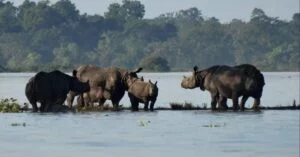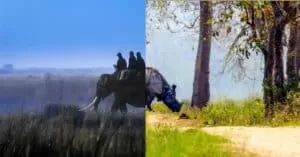Kaziranga National Park in Assam is known for the Big Five group of animals. The Big five animals of Kaziranga refers to One horned Rhinoceros , Tiger, Elephant, Asiatic Wild Buffalo and the Eastern Swamp Deer. It is the only place in the world where all these five animals are found in a single habibat. The National park and tiger reserve having an area of more than 1000 sq. km accommodate diverse flora and fauna some of which are endemic to the region of Assam.Only in Kaziranga National Park and Tiger Reserve, you can witsess the big five in their wild habibate. In this blog, you will get to know how to visit Kaziranga National Park to witness the big five.
The Big Five Animals of Kaziranga National Park

♦ One-Horned Rhinoceros: Kaziranga is renowned for its population of one-horned rhinoceros, a critically endangered species. The park is home to a significant number of these majestic creatures, making it one of the most important strongholds for their conservation.
♦ Bengal Tiger: Tigers are the apex predators in Kaziranga. While they are elusive, the park offers a chance to spot these magnificent cats, especially during the winter months when they venture into the core areas for prey.
♦ Asian Elephant: The park hosts a thriving population of Asian elephants. Visitors can witness herds of these gentle giants as they roam through the grasslands and forests of Kaziranga.
♦ Wild Water Buffalo: Kaziranga is known for its population of wild water buffalo, a species that once teetered on the brink of extinction. The park has played a pivotal role in their recovery.
♦ Eastern Swamp Deer: Also known as the barasingha, the eastern swamp deer is another highlight of Kaziranga’s wildlife. The park provides a vital habitat for this species, which is adapted to wetland environments.
Current approximate population of the big five animals of Kaziranga National Park as of 2023:
- Rhinoceros – 2,400
- Tiger- 140
- Elephant- 1200
- Asiatic Wild Buffalo and the Eastern Swamp Deer – 1500
Reason behind the existence of Big Five
The existence of all five species in Kaziranga National Park can be attributed to a confluence of various crucial factors that collectively contribute to the area’s exceptional biodiversity and conservation success.
♦ Favorable Climate and Ecosystem: Kaziranga National Park is situated in a region with a favorable climate and diverse ecosystems. The park’s location in the northeastern part of India offers a unique blend of tropical and subtropical conditions, creating a rich and varied habitat for wildlife. The park’s varied landscape, which includes wetlands, grasslands, and dense forests, provides an ideal environment for different species to thrive. This diversity ensures that a wide range of flora and fauna can find suitable niches within the park.
♦ Conservation Efforts of KNP Authority: The diligent and committed efforts of Kaziranga National Park’s authorities and dedicated conservationists have played a pivotal role in the survival and protection of these five species. Through anti-poaching measures, habitat restoration, and community engagement programs, the park authorities have established a safe haven for wildlife. Their dedication to preserving the park’s natural resources and its unique inhabitants is a testament to the successful conservation efforts.
♦ Huge Geographical Expanse: Kaziranga National Park covers a vast geographical area, spreading across approximately 1000 square kilometers. This large expanse allows the park to support viable populations of various species. The ample space provides ample room for animals to roam freely, find food, establish territories, and reproduce. This, in turn, contributes to the sustainability of these species within the park.
♦ Great Brahmaputra River: The presence of the mighty Brahmaputra River flowing through the heart of Kaziranga National Park is a crucial factor in the preservation of the ecosystem. The river acts as a natural barrier, limiting human encroachment into the park and helping maintain the integrity of its boundaries. It also plays a significant role in providing water sources for the park’s inhabitants, particularly during the dry seasons when water can be scarce.
♦ Presence of Various Small Water Bodies: In addition to the Brahmaputra River, Kaziranga is dotted with numerous small water bodies, such as ponds, lakes, and marshes. These water sources are vital for both large herbivores and predators, ensuring that the park can sustain a diverse range of wildlife. They also serve as gathering points for various species, making them essential for observing and conserving the park’s wildlife.
Learn more about geography and area of Kaziranga National Park in this blog
Where to spot the big five in Kaziranga National Park
Of all five animals, the Asiatic wild buffalo is the easiest to spot. There were seen even in the outskirts or eco-sensitive zone of the Kaziranga National park. They are also called Water Buffalo as they like to spend hot sunny days in the swamp. Elephant and Eastern Swamp Deer are the next. They are easily seen in buffer zone of the area. However, herds of elephants crossing national highway is a common scene. Sometimes herds of elephants raid neighboring villages causing loss of man and material. Similarly, you can easily spot one horned rhinoceros within the buffer zone. Of all the big five animals of Kaziranga National Park, Tiger is the hardest to spot. They mainly live in the core zone of the National Park.
How to spot all big five animals of Kaziranga in one trip?
In order to have a clear view or click pictures of these animals, one must take safari services. Kaziranga National Park Authority provides two types of Safari (Jeep and Elephant) options in all four zones of the Park. However, if you want spot all the big five animals of Kaziranga in one go, then you must choose Jeep safari. Because Jeep safari is quickest way and safari time within the Kaziranga National Park is limited i.e. two hours. The jeep drivers are skillful and knowledgeable enough to drive you the best places an watchtowers.
Similarly, there are four safari zones in Kaziranga namely: Kohora (Central) Range , Bagori (Western) Range , Agaratoli (Eastern) Range and Burapahar (Ghorakati/South Eastern) Range. If you want to spot all the big five animals of Kaziranga, choose Kohora (Central) Range.
So, a jeep safari in the Kohora (Central) Range of Kaziranga National Park is the best option for those seeking to the big five animals of Kaziranga and an exceptional wildlife adventure. The Kohora Range boasts a high probability of sighting the big five animals of Kaziranga i.e. Bengal tiger, one-horned rhinoceros, asiatic elephants, wild buffalo, and swamp deer.
Best Time to visit and spot the big five animals of Kaziranga
Visiting the Kohora Zone of Kaziranga National Park for a safari from November to April is an excellent choice, as this period allows for a more comfortable and safe wildlife viewing experience. The closure of the park from May to October is a necessary precaution due to the monsoon season, when the park experiences heavy rainfall and flooding, making it unsafe for visitors and difficult to spot wildlife.
As Tiger is hardest to spot, we must talk about tiger spotting time. During the winter season, tigers tend to venture into the outer areas of the park in search of prey, making them more likely to be seen by visitors. The reduced vegetation during this time also improves visibility. Winter (January-February) is the best season to spot Tigers. However, you can spot the other four of the big five, anytime of the year.
However, it’s important to note that wildlife sightings are never guaranteed, as animals, including tigers, are inherently elusive. Factors such as weather conditions, time of day, and sheer luck play a significant role in wildlife encounters. To maximize your chances of seeing tigers and other wildlife, it’s advisable to go on multiple safaris, preferably during the early morning or late afternoon when animals are more active.
Booking and Price of Jeep Safari in Kaziranga
Offline Booking: The best way to book a Kaziranga safari offline is by visiting the Kaziranga National Park office near NH30 in Nagaon district.
Online Booking: When booking online, it’s strongly recommended to use the official website of Kaziranga National Park for the most authentic and reliable service. Many third-party websites may not guarantee availability and authenticity, so relying on the official website ensures a hassle-free and trustworthy reservation process. Here is the link of official website.
How To Book Online Safari in Kaziranga
- Visit the official website – https://kazirangasafari.in/booking/
- Log in with your mobile number
- Select safari type (Jeep/Elephant)
- Select Safari Range (Kohora/Bagori/Agaratoli/ Burapahar)
- Fill up your basic details (Name, Nationality, Address etc.)
- Upload the photo of govt. approved id card (Pan Card/Aadhaar Card/Driving License etc.)
- Select the safari time slot (07:30 Am- 10:00 AM/ 01:30 PM – 03:00 PM)
- Choose the no of jeep (Maximum person in a jeep is 6)
- Select camera equipments you are carrying (you will have to pay extra for this)
- Then make the payment.
- Make sure enter correct date for making the payment
Here is the screenshot of a booking and price (with one professional still camera)

So, the price of safari booking in Kaziranga National Park is Rs 510 per person for Indian citizen if you are not carrying any camera. However, booking prices increases depending on your camera.
Note: Jeep hiring and pickup fee are not included in the ticket. Per person jeep hiring and pickup price is normally 4000 for Indian citizen and 7000 for foreigners for Kohora range. Jeep hiring price changes with demand.
















